A Comprehensive Analysis of Modern Chinese History
VerifiedAdded on 2022/12/26
|7
|1820
|98
Essay
AI Summary
This essay provides a comprehensive overview of Chinese history, beginning with an image of Tiananmen Square and referencing Jonathan D. Spence's 'The Search for Modern China'. It explores the establishment of the People's Republic of China, the roles of Mao Zedong and Deng Xiaoping, and significant events like the Tiananmen Massacre. The essay also examines Chiang Kai-shek's influence, the impact of the Chinese Communist Revolution, and the transformative effects of Mao's rule, including the Great Leap Forward, the Hundred Flowers Campaign, and the Cultural Revolution. Furthermore, it discusses the Chinese economic reform, land reform laws, and the societal changes that occurred during this period. The essay highlights the complexities of China's historical development, including the contradictions within the society, the impact of various political campaigns, and the evolution of women's roles.
Contribute Materials
Your contribution can guide someone’s learning journey. Share your
documents today.
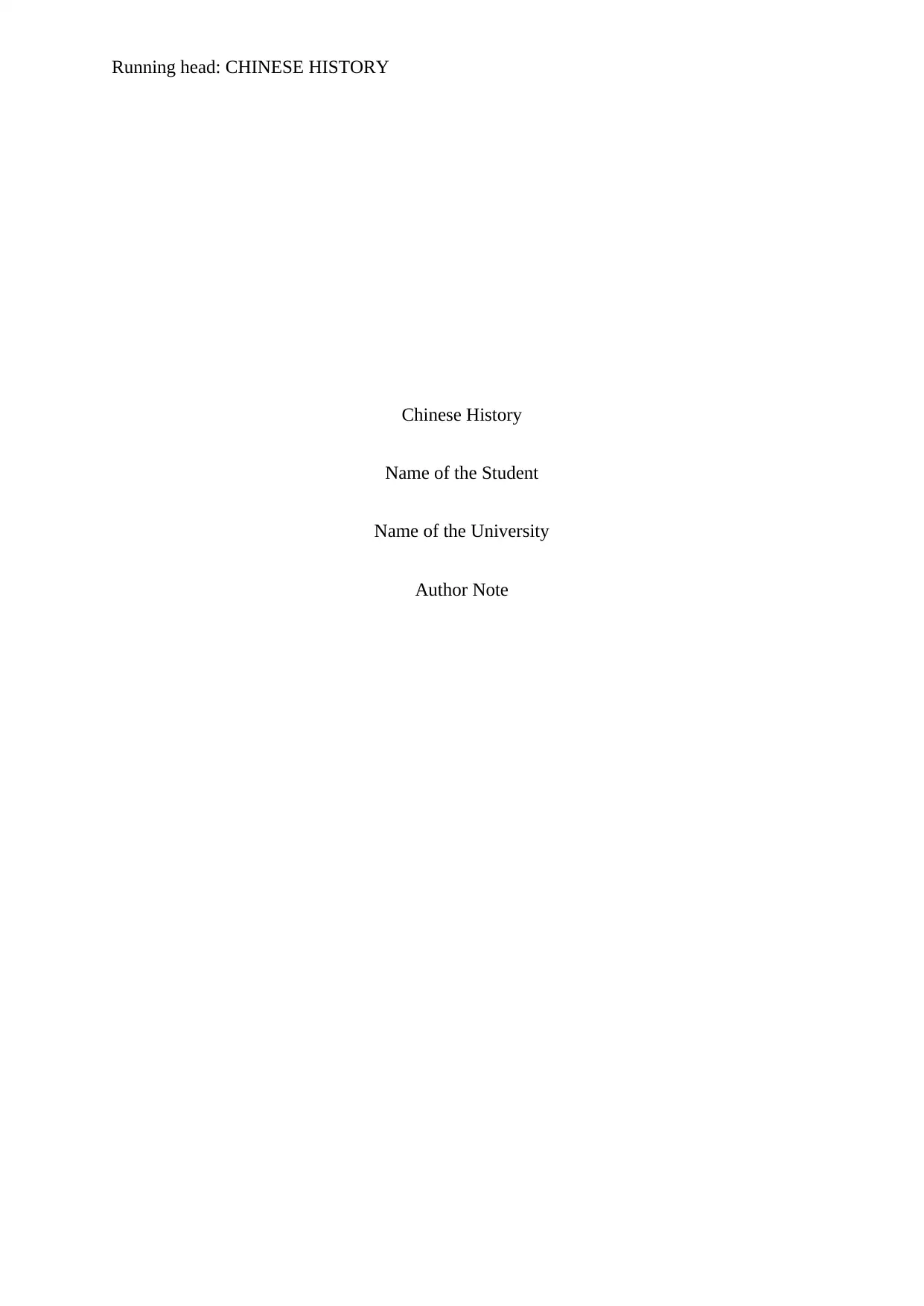
Running head: CHINESE HISTORY
Chinese History
Name of the Student
Name of the University
Author Note
Chinese History
Name of the Student
Name of the University
Author Note
Secure Best Marks with AI Grader
Need help grading? Try our AI Grader for instant feedback on your assignments.
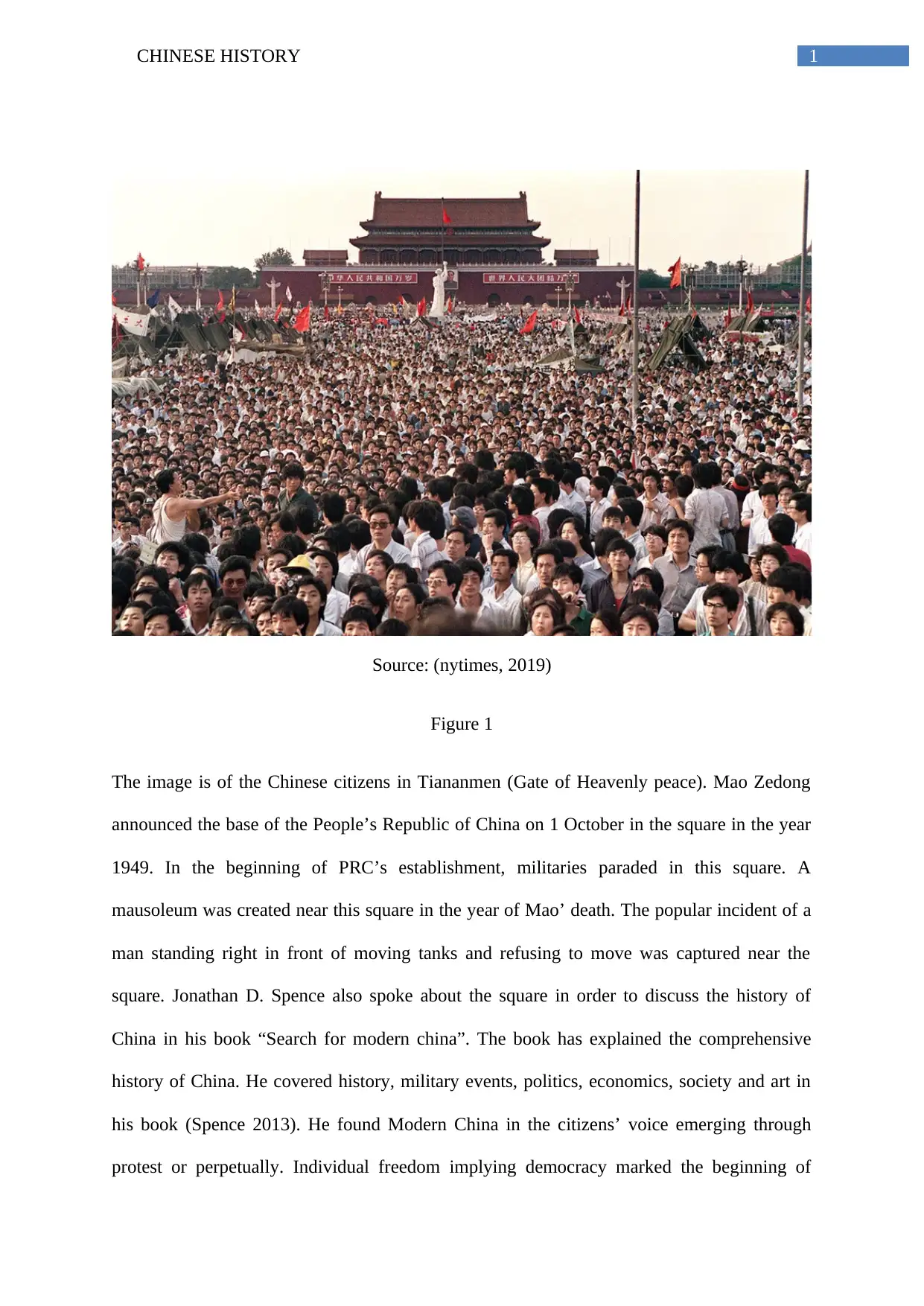
1CHINESE HISTORY
Source: (nytimes, 2019)
Figure 1
The image is of the Chinese citizens in Tiananmen (Gate of Heavenly peace). Mao Zedong
announced the base of the People’s Republic of China on 1 October in the square in the year
1949. In the beginning of PRC’s establishment, militaries paraded in this square. A
mausoleum was created near this square in the year of Mao’ death. The popular incident of a
man standing right in front of moving tanks and refusing to move was captured near the
square. Jonathan D. Spence also spoke about the square in order to discuss the history of
China in his book “Search for modern china”. The book has explained the comprehensive
history of China. He covered history, military events, politics, economics, society and art in
his book (Spence 2013). He found Modern China in the citizens’ voice emerging through
protest or perpetually. Individual freedom implying democracy marked the beginning of
Source: (nytimes, 2019)
Figure 1
The image is of the Chinese citizens in Tiananmen (Gate of Heavenly peace). Mao Zedong
announced the base of the People’s Republic of China on 1 October in the square in the year
1949. In the beginning of PRC’s establishment, militaries paraded in this square. A
mausoleum was created near this square in the year of Mao’ death. The popular incident of a
man standing right in front of moving tanks and refusing to move was captured near the
square. Jonathan D. Spence also spoke about the square in order to discuss the history of
China in his book “Search for modern china”. The book has explained the comprehensive
history of China. He covered history, military events, politics, economics, society and art in
his book (Spence 2013). He found Modern China in the citizens’ voice emerging through
protest or perpetually. Individual freedom implying democracy marked the beginning of

2CHINESE HISTORY
modern China. He marked the various strands influencing the development and changes in
this country. He has mentioned about the internal conditions of China. He also mentioned
about the philosophical and sociological trends and foundations and its relationship with rest
of the world. He has portrayed the role of various political leaders (Spence 2013). Mainly he
has discussed the rule of Mao Zedong and Deng Xiaoping. He was unable to depict the real
personalities of these leaders. It also speaks about the Tiananmen Massacre which occurred in
the year 1989. Cultural trends of the Chinese people were mentioned. Jonathan D. Spence
focused on discussing the evolution of modern China and its background. The difficulties
faced by the citizens were also explained vividly. The supporter of Chiang Kai Shek and his
actions along with history of bloodbath because of the Cultural Revolution were mentioned in
the book.
Political leader and a member of the military in China, Chiang Kai-shek had joined
the National Party or KMT in the year 1918. In the year 1925, he expelled the communists of
the party and concentrated on the unification of China. Chiang’s governance mainly focused
on the battle with communist party in China and to manage the aggression of Japan. Chiang
expelled the nationalist party to Taiwan, which was considered as the legitimate government
of china by many countries all over the world. Chiang wanted to put forward various reforms,
improvement in the Chinese infrastructure and reviving the Confucianism. This was done by
‘New Life Movement’ campaign. This acted as threat in the stability of economy outside and
within the country. His generals seized him on December 1936 until he decided to support
Mao Zedong’s forces of communism against Japan. China was invaded by Japan the next
year. China struggled for four years until war was declared on Japan in the year 1941. The
citizens due to his passivity towards the Japanese did not support Chiang’s government and
conservative policies that only favored the mercantile interests and the landowners. In the
year 1946, Japan surrendered and civil war was announced between the Communist forces
modern China. He marked the various strands influencing the development and changes in
this country. He has mentioned about the internal conditions of China. He also mentioned
about the philosophical and sociological trends and foundations and its relationship with rest
of the world. He has portrayed the role of various political leaders (Spence 2013). Mainly he
has discussed the rule of Mao Zedong and Deng Xiaoping. He was unable to depict the real
personalities of these leaders. It also speaks about the Tiananmen Massacre which occurred in
the year 1989. Cultural trends of the Chinese people were mentioned. Jonathan D. Spence
focused on discussing the evolution of modern China and its background. The difficulties
faced by the citizens were also explained vividly. The supporter of Chiang Kai Shek and his
actions along with history of bloodbath because of the Cultural Revolution were mentioned in
the book.
Political leader and a member of the military in China, Chiang Kai-shek had joined
the National Party or KMT in the year 1918. In the year 1925, he expelled the communists of
the party and concentrated on the unification of China. Chiang’s governance mainly focused
on the battle with communist party in China and to manage the aggression of Japan. Chiang
expelled the nationalist party to Taiwan, which was considered as the legitimate government
of china by many countries all over the world. Chiang wanted to put forward various reforms,
improvement in the Chinese infrastructure and reviving the Confucianism. This was done by
‘New Life Movement’ campaign. This acted as threat in the stability of economy outside and
within the country. His generals seized him on December 1936 until he decided to support
Mao Zedong’s forces of communism against Japan. China was invaded by Japan the next
year. China struggled for four years until war was declared on Japan in the year 1941. The
citizens due to his passivity towards the Japanese did not support Chiang’s government and
conservative policies that only favored the mercantile interests and the landowners. In the
year 1946, Japan surrendered and civil war was announced between the Communist forces
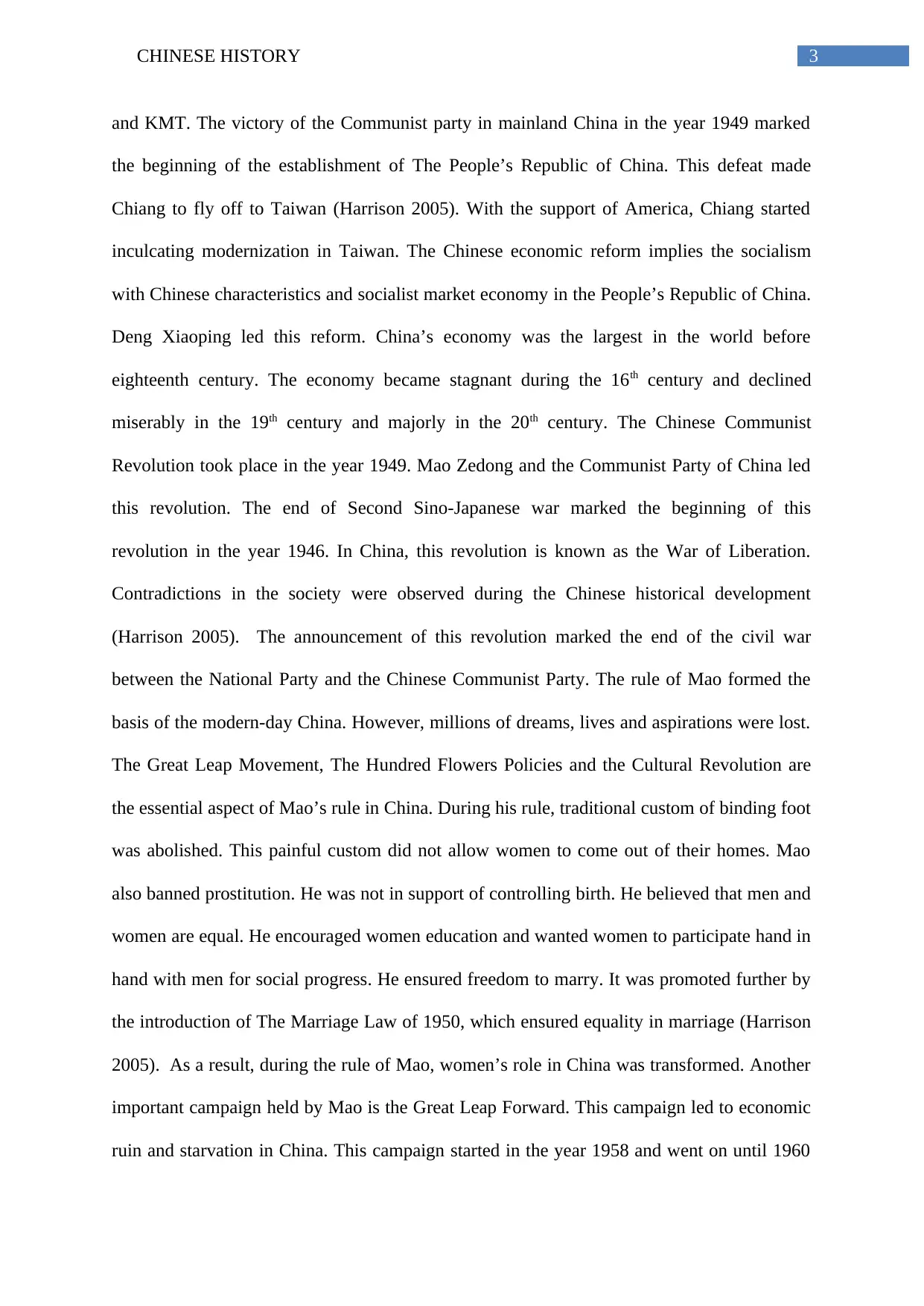
3CHINESE HISTORY
and KMT. The victory of the Communist party in mainland China in the year 1949 marked
the beginning of the establishment of The People’s Republic of China. This defeat made
Chiang to fly off to Taiwan (Harrison 2005). With the support of America, Chiang started
inculcating modernization in Taiwan. The Chinese economic reform implies the socialism
with Chinese characteristics and socialist market economy in the People’s Republic of China.
Deng Xiaoping led this reform. China’s economy was the largest in the world before
eighteenth century. The economy became stagnant during the 16th century and declined
miserably in the 19th century and majorly in the 20th century. The Chinese Communist
Revolution took place in the year 1949. Mao Zedong and the Communist Party of China led
this revolution. The end of Second Sino-Japanese war marked the beginning of this
revolution in the year 1946. In China, this revolution is known as the War of Liberation.
Contradictions in the society were observed during the Chinese historical development
(Harrison 2005). The announcement of this revolution marked the end of the civil war
between the National Party and the Chinese Communist Party. The rule of Mao formed the
basis of the modern-day China. However, millions of dreams, lives and aspirations were lost.
The Great Leap Movement, The Hundred Flowers Policies and the Cultural Revolution are
the essential aspect of Mao’s rule in China. During his rule, traditional custom of binding foot
was abolished. This painful custom did not allow women to come out of their homes. Mao
also banned prostitution. He was not in support of controlling birth. He believed that men and
women are equal. He encouraged women education and wanted women to participate hand in
hand with men for social progress. He ensured freedom to marry. It was promoted further by
the introduction of The Marriage Law of 1950, which ensured equality in marriage (Harrison
2005). As a result, during the rule of Mao, women’s role in China was transformed. Another
important campaign held by Mao is the Great Leap Forward. This campaign led to economic
ruin and starvation in China. This campaign started in the year 1958 and went on until 1960
and KMT. The victory of the Communist party in mainland China in the year 1949 marked
the beginning of the establishment of The People’s Republic of China. This defeat made
Chiang to fly off to Taiwan (Harrison 2005). With the support of America, Chiang started
inculcating modernization in Taiwan. The Chinese economic reform implies the socialism
with Chinese characteristics and socialist market economy in the People’s Republic of China.
Deng Xiaoping led this reform. China’s economy was the largest in the world before
eighteenth century. The economy became stagnant during the 16th century and declined
miserably in the 19th century and majorly in the 20th century. The Chinese Communist
Revolution took place in the year 1949. Mao Zedong and the Communist Party of China led
this revolution. The end of Second Sino-Japanese war marked the beginning of this
revolution in the year 1946. In China, this revolution is known as the War of Liberation.
Contradictions in the society were observed during the Chinese historical development
(Harrison 2005). The announcement of this revolution marked the end of the civil war
between the National Party and the Chinese Communist Party. The rule of Mao formed the
basis of the modern-day China. However, millions of dreams, lives and aspirations were lost.
The Great Leap Movement, The Hundred Flowers Policies and the Cultural Revolution are
the essential aspect of Mao’s rule in China. During his rule, traditional custom of binding foot
was abolished. This painful custom did not allow women to come out of their homes. Mao
also banned prostitution. He was not in support of controlling birth. He believed that men and
women are equal. He encouraged women education and wanted women to participate hand in
hand with men for social progress. He ensured freedom to marry. It was promoted further by
the introduction of The Marriage Law of 1950, which ensured equality in marriage (Harrison
2005). As a result, during the rule of Mao, women’s role in China was transformed. Another
important campaign held by Mao is the Great Leap Forward. This campaign led to economic
ruin and starvation in China. This campaign started in the year 1958 and went on until 1960
Secure Best Marks with AI Grader
Need help grading? Try our AI Grader for instant feedback on your assignments.

4CHINESE HISTORY
(Lu Xun 2009). The government’s plan was to control the agricultural sales of goods. This
would have been easier if agriculture was made centralized. This implies that the farming
collectives will share the workload and its necessary tools. Higher goals were set but it was
far from the reality. People from China starved to death. The leaders of communes were
continuously lying to their superiors about the level of production. Meanwhile, grains were
exported to various parts of the world and to various urban places in China. This caused the
peasants to starve. This movement started the production of steel. This led to melting of the
farming implements and cooking pots of kitchen. In order to continue with this, people burnt
their household furniture and doors. Later, Mao’s tour to the steel production factories made
him realize that the production of steel was not possible in the backyard furnace. Soon after
that, the production of steel was abolishes, causing economic change in the country. During
this campaign approximately 40 million lost their lives due to starvation. It was formally
stopped in the year 1961. Mao’s Hundred Flowers Campaign was to know the opinions of the
citizens about the how to lead China. They were given the authority to express their point of
view. Intellectual community of China came forward. Few months after this, the campaign
was halted as people started complaining about the government. This campaign was called as
the Anti-Rightist Movement. When peace persisted in China and growth of the economic
condition of the country marked the beginning of a new era, Mao Zedong, leader of China’s
communist party launched the Cultural Revolution. His primary motive of this revolution was
to remove the contaminated elements of China and regain the revolutionary spirit of Chinese
people. The Cultural Revolution continued until the death of Mao. Political instabilities were
conquering the country’s well-being and the capability of the government to provide services
and goods had declined immensely. During this time, young adults were deprived of
education; corruption grew in the government and within the CCP. The system and CCP
leadership suffered a major loss of legitimacy. As the members of anti Cultural Revolution
(Lu Xun 2009). The government’s plan was to control the agricultural sales of goods. This
would have been easier if agriculture was made centralized. This implies that the farming
collectives will share the workload and its necessary tools. Higher goals were set but it was
far from the reality. People from China starved to death. The leaders of communes were
continuously lying to their superiors about the level of production. Meanwhile, grains were
exported to various parts of the world and to various urban places in China. This caused the
peasants to starve. This movement started the production of steel. This led to melting of the
farming implements and cooking pots of kitchen. In order to continue with this, people burnt
their household furniture and doors. Later, Mao’s tour to the steel production factories made
him realize that the production of steel was not possible in the backyard furnace. Soon after
that, the production of steel was abolishes, causing economic change in the country. During
this campaign approximately 40 million lost their lives due to starvation. It was formally
stopped in the year 1961. Mao’s Hundred Flowers Campaign was to know the opinions of the
citizens about the how to lead China. They were given the authority to express their point of
view. Intellectual community of China came forward. Few months after this, the campaign
was halted as people started complaining about the government. This campaign was called as
the Anti-Rightist Movement. When peace persisted in China and growth of the economic
condition of the country marked the beginning of a new era, Mao Zedong, leader of China’s
communist party launched the Cultural Revolution. His primary motive of this revolution was
to remove the contaminated elements of China and regain the revolutionary spirit of Chinese
people. The Cultural Revolution continued until the death of Mao. Political instabilities were
conquering the country’s well-being and the capability of the government to provide services
and goods had declined immensely. During this time, young adults were deprived of
education; corruption grew in the government and within the CCP. The system and CCP
leadership suffered a major loss of legitimacy. As the members of anti Cultural Revolution
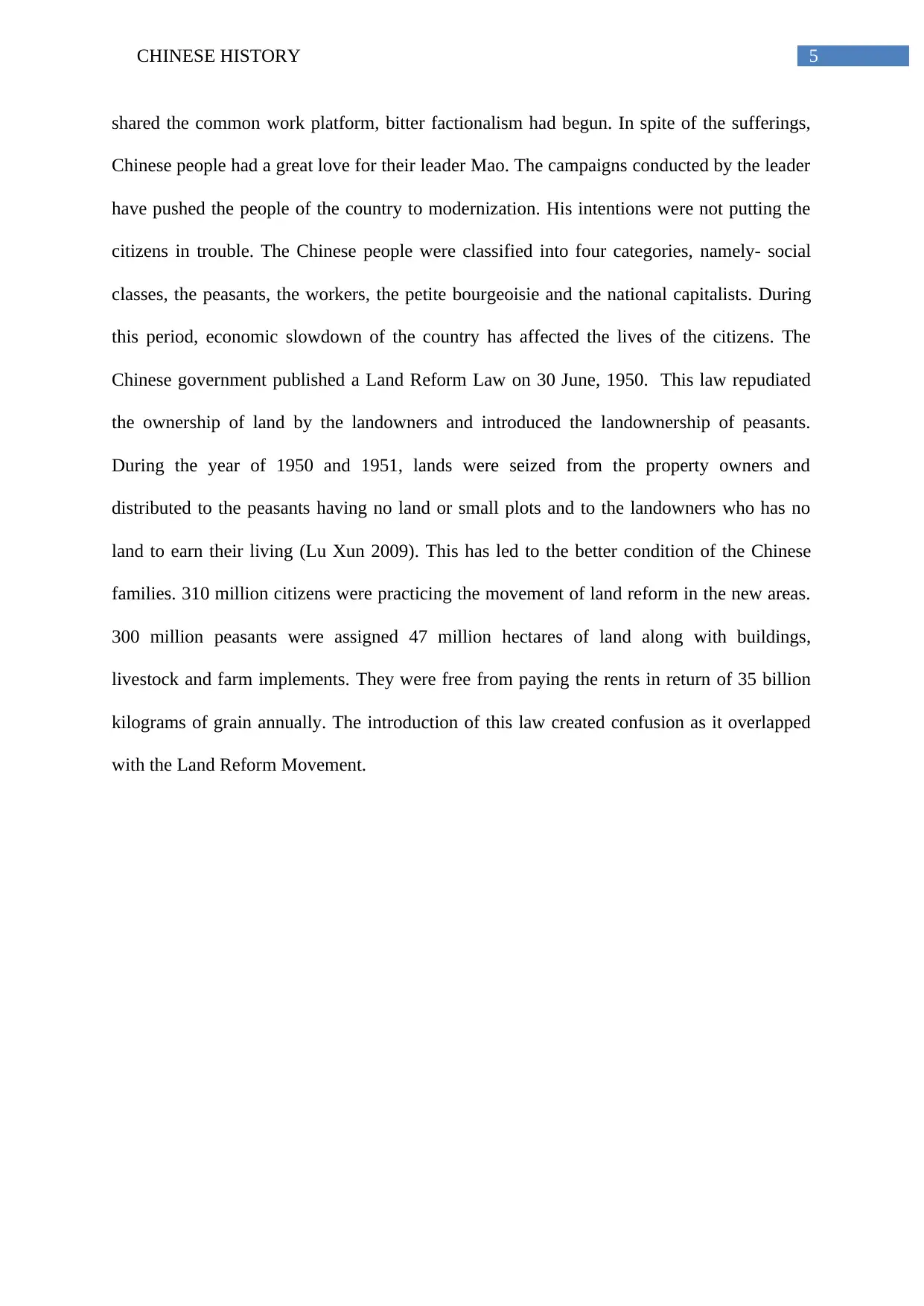
5CHINESE HISTORY
shared the common work platform, bitter factionalism had begun. In spite of the sufferings,
Chinese people had a great love for their leader Mao. The campaigns conducted by the leader
have pushed the people of the country to modernization. His intentions were not putting the
citizens in trouble. The Chinese people were classified into four categories, namely- social
classes, the peasants, the workers, the petite bourgeoisie and the national capitalists. During
this period, economic slowdown of the country has affected the lives of the citizens. The
Chinese government published a Land Reform Law on 30 June, 1950. This law repudiated
the ownership of land by the landowners and introduced the landownership of peasants.
During the year of 1950 and 1951, lands were seized from the property owners and
distributed to the peasants having no land or small plots and to the landowners who has no
land to earn their living (Lu Xun 2009). This has led to the better condition of the Chinese
families. 310 million citizens were practicing the movement of land reform in the new areas.
300 million peasants were assigned 47 million hectares of land along with buildings,
livestock and farm implements. They were free from paying the rents in return of 35 billion
kilograms of grain annually. The introduction of this law created confusion as it overlapped
with the Land Reform Movement.
shared the common work platform, bitter factionalism had begun. In spite of the sufferings,
Chinese people had a great love for their leader Mao. The campaigns conducted by the leader
have pushed the people of the country to modernization. His intentions were not putting the
citizens in trouble. The Chinese people were classified into four categories, namely- social
classes, the peasants, the workers, the petite bourgeoisie and the national capitalists. During
this period, economic slowdown of the country has affected the lives of the citizens. The
Chinese government published a Land Reform Law on 30 June, 1950. This law repudiated
the ownership of land by the landowners and introduced the landownership of peasants.
During the year of 1950 and 1951, lands were seized from the property owners and
distributed to the peasants having no land or small plots and to the landowners who has no
land to earn their living (Lu Xun 2009). This has led to the better condition of the Chinese
families. 310 million citizens were practicing the movement of land reform in the new areas.
300 million peasants were assigned 47 million hectares of land along with buildings,
livestock and farm implements. They were free from paying the rents in return of 35 billion
kilograms of grain annually. The introduction of this law created confusion as it overlapped
with the Land Reform Movement.
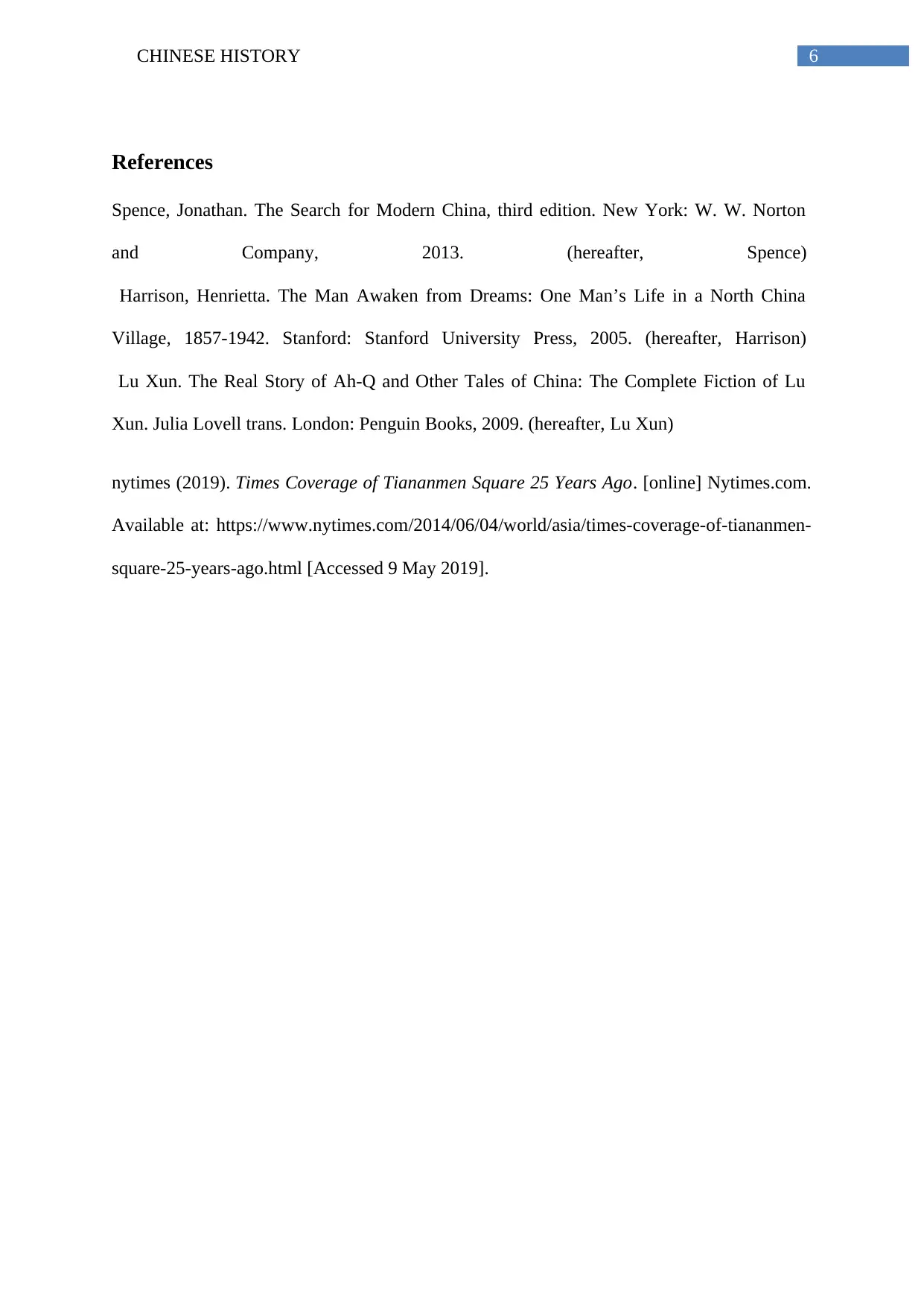
6CHINESE HISTORY
References
Spence, Jonathan. The Search for Modern China, third edition. New York: W. W. Norton
and Company, 2013. (hereafter, Spence)
Harrison, Henrietta. The Man Awaken from Dreams: One Man’s Life in a North China
Village, 1857-1942. Stanford: Stanford University Press, 2005. (hereafter, Harrison)
Lu Xun. The Real Story of Ah-Q and Other Tales of China: The Complete Fiction of Lu
Xun. Julia Lovell trans. London: Penguin Books, 2009. (hereafter, Lu Xun)
nytimes (2019). Times Coverage of Tiananmen Square 25 Years Ago. [online] Nytimes.com.
Available at: https://www.nytimes.com/2014/06/04/world/asia/times-coverage-of-tiananmen-
square-25-years-ago.html [Accessed 9 May 2019].
References
Spence, Jonathan. The Search for Modern China, third edition. New York: W. W. Norton
and Company, 2013. (hereafter, Spence)
Harrison, Henrietta. The Man Awaken from Dreams: One Man’s Life in a North China
Village, 1857-1942. Stanford: Stanford University Press, 2005. (hereafter, Harrison)
Lu Xun. The Real Story of Ah-Q and Other Tales of China: The Complete Fiction of Lu
Xun. Julia Lovell trans. London: Penguin Books, 2009. (hereafter, Lu Xun)
nytimes (2019). Times Coverage of Tiananmen Square 25 Years Ago. [online] Nytimes.com.
Available at: https://www.nytimes.com/2014/06/04/world/asia/times-coverage-of-tiananmen-
square-25-years-ago.html [Accessed 9 May 2019].
1 out of 7
Related Documents
Your All-in-One AI-Powered Toolkit for Academic Success.
+13062052269
info@desklib.com
Available 24*7 on WhatsApp / Email
![[object Object]](/_next/static/media/star-bottom.7253800d.svg)
Unlock your academic potential
© 2024 | Zucol Services PVT LTD | All rights reserved.




